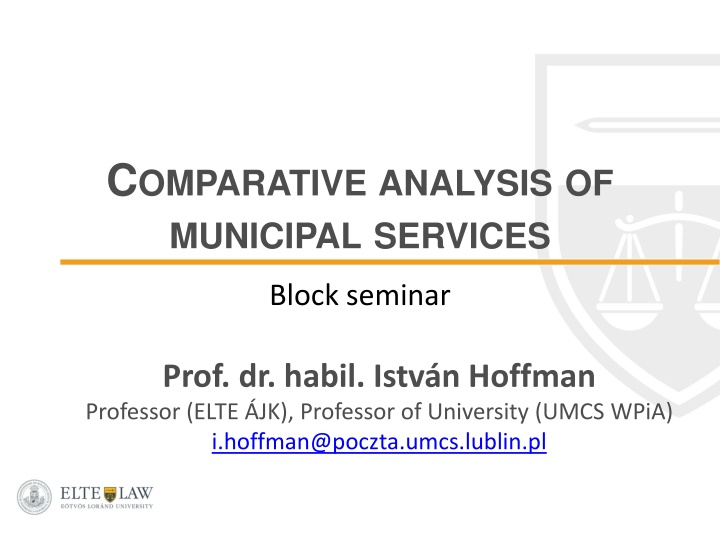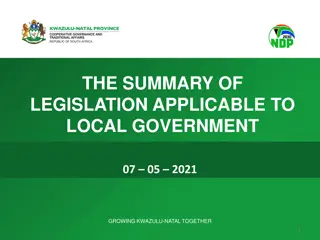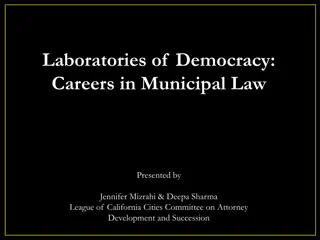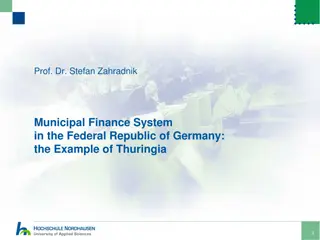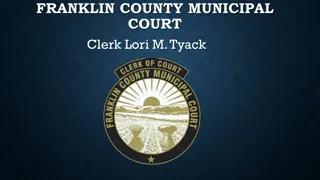Comparative Analysis of Municipal Services in Public Sector Evolution
Explore the evolution and role of public services in the municipal sector through a comparative analysis presented in a block seminar by Prof. István Hoffman. Delve into the general theory of public services, the traditional and changing approaches of public administration, and government expenditures in the EU-27. Understand different interdisciplinary perspectives on public services and the concept of government services, as well as the relationship between public services and the public in economics, sociology, and jurisprudence.
Download Presentation

Please find below an Image/Link to download the presentation.
The content on the website is provided AS IS for your information and personal use only. It may not be sold, licensed, or shared on other websites without obtaining consent from the author.If you encounter any issues during the download, it is possible that the publisher has removed the file from their server.
You are allowed to download the files provided on this website for personal or commercial use, subject to the condition that they are used lawfully. All files are the property of their respective owners.
The content on the website is provided AS IS for your information and personal use only. It may not be sold, licensed, or shared on other websites without obtaining consent from the author.
E N D
Presentation Transcript
COMPARATIVE ANALYSIS OF MUNICIPAL SERVICES Block seminar Prof. dr. habil. Istv n Hoffman Professor (ELTE JK), Professor of University (UMCS WPiA) i.hoffman@poczta.umcs.lublin.pl
General theory of public services INTRODUCTION
Public services and public law Traditional approach: public administration as public power Service provider role of the public administration Changing role of the public administration in the 20th century: Forsthoff: administration as service provider
Government expenditures in EU-27 (with UK, without Croatia) in 2017 13.5 3 3.9 39.9 8.2 1.7 1.7 10.9 14.9 2.2 1. ltal nos k zszolg ltat sok 2.V delmi kiad sok 3.K zrend s k zbiztons g 4.Gazdas gi gyek 5.K rnyezetv delem 6.Lakhat si gyek 7.Eg szs g gyi kiad sok 8.K zm vel d s, kultur lis s vall si gyek 9.Oktat s 10.Szoci lis v delmi kiad sok
Different approaches of the concept of public service Different sciences different approaches Economics: the economic elements of the public services Sociology: public services and public needs Administrative sciences: public services and their management Jurisprudence: public services as legal institutions and legal phenomena Complex, multi- and interdisciplinary analysis is required.
Public services as services Economics, sociology: Broad approach of services: the thrid sector Government services as services Administrative sciences Broader: based on the concept of government services Broad: services excluded the public power Narrow: only the personal nature services, cash benefits excluded Jurisprudence: Legal definitions, different approaches in different rules
Public services and the public (1) Economics: Public goods mixed goods private goods Market failures and public services Monopol and oligopol structures Externalities High transaction costs Information asymmetry Sociology and social policy: Concept of governance: from consumer to citizen Concept of best value Accountability Co-creation: nothing about us without us
Public services and the public (2) Definition of public services: practically by legal norms Procedure of the definition is regulated by the law Constitutions, acts as tools of the definitions Concepts on the role of public adminstration: Provider state Regulator state share of the role (regulation provision supervision) Cooperating state
Models Service public French based model Broad concept: organisation, activities, ethics Daseinsvorsorge Organisation centered Public service Public and private NPM and after Changes of the NPM Post-NPM: Good Governance, NPS, Neo-Weberian State
Municipal models in the liberal democracies MUNICIPAL MODELS
Anglo-Saxon model Ultra vires model and its transformation Concept of sovereignty Transformation in England: from ultra vires to general clause model United States: Dillon, home rule, municipal home rule Municipal tasks: a monist approach Organisation Different approaches: cabinet system, city manager, elected mayors Finance and asset: broad (legal) autonomy State supervision: fragmented, but at the central level
French (Latin) model General clause (based on the concept of undivided state sovereignty) Dual task system Municipal tasks Delegated (state) tasks Organisation Strong mayors, weak councils, inter-municipal associations Finance and asset: strong central powers Supervision: prefectures! (Changes after the 80s )
German model General clause (inherent municipal powers) Dual task system Different municipal administration systems Inter-municipal associations: obligatory assocaitons (!) Finance and asset Supervision: developed dogmatics (legal and professional supervision)
Scandinavia A continental model Merge of the communities Wide range of municipal tasks Organisation: significant role of the municipal committees
The conceptual framework of the analysis COMPARISON OF MUNICIPAL TASKS
Introductory remarks Analysis of the public administration: Different approaches Different elements Legal comparison and public administration The main field of the comparative law The evolvement and development of comparative administrative law comparative municipal law
Jurisprudential comparison Different levels of the comparison First level: country studies Second level: comparison of the legal institutions Formerly the majority of the books on comparative legal analysis: country studies Changing methods: see Bogdandy et al. (2014) and Rose-Ackermann et al. (2017)
Comparative municipal law Federal countries Approaches of the municipal law Broad sense: Anglo-Saxon Narrow sense: continental Convergence of the systems (see Localism Act 2011) The subject of the analysis Majority of the analysis: narrow sense: focused on constitutional status, organisation and general questions Broad sense: comparison of the municipal tasks is part of the analysis
Comparative local governance Based on the methods of political sceinces, economics and partly jurisprudential elements administrative sciences Concept of subnational (local and regional governance) (blur of the distinctions in administrative and constitutional law) Approaches Municipal reforms (firstly NPM, form the 2000s post- NPM, Good Governance, NWS based etc.) Territorial aspects (economies of scale, borders, merge of municipalities) Decision making
Why we need comparative municipal law? The significance of the legal institutions Questions on the nature of the subnational units Broad sense: Organisation is important, BUT the analysis of the tasks are required (see the example pf Hungary) Multidimensional model
First dimension: constitutional staus and traditions Constitutional status is important: the framework of the system ultra vires vs. continental model Convergence of the models Multi-level governance systems (and the European integration)
Second dimension: the role of the sectoral policies and approaches The tasks of the municipalities are strongly impacted by sectoral policies Interaction between the sectoral policies and the constitutional model of the municipalities Interaction between the Nordic municipal system and the Nordic welfare model Spatial structure Tiers of the local governments as influencing factor Size of the municipalities, economy of scale problems Centralization Merge of municipalities Inter-municipal cooperation
Third dimension: model of the public service provision system Municipal tasks are strongly influenced by the service provision role of the given state Les Trentes Glorieuses and the welfare state (interactions between the service provider role and the municipal organization) The influence of the reforms NPM Good Governance Public Choices NWS
Multi-dimensiopnal analysis Jurisprudential analysis have advantages! Focuesed on the analysis of legal institituions on municipal tasks Multi-dimensional approach Analysis of legal institutions on organization (constitutional status) Analysis of the sectoral legal institutions Analysis of rules on spatial structure Analysis of the legal institutions of the public service system
Public utilities as municipal tasks MUNICIPAL PUBLIC UTILITIES
Public utilities and models of municipal tasks It depends on the concept of the public service provision (the impact of the municipal organisational system is limited) Main models: Anglo-Saxon German (Daseinsvorsorge) French (service public) Main questions: Private or public providers Definition of the price of the public service Supervision by authorities / agencies
Water and sewage utilities Different models It can be classified: centralisation and concentration: First-tier centered (Hungary) Regional-based (UK, France) Shared responsibilities (Germany) Secondly: private and public roles Dual (parallel) model (Public/private) Germany Private model with a strong supervision ofthe public administration (UK) Public-based model with(the possibility of) private providers
Waste management (1): responsibilities Primarily first- tier based model Shared responsibility Primarily regional based model For example: Austria, the majority of the German provinces (L nder) etc. For example: France (commune d partement r gion) Some of the German provinces (L nder) For example: United Kingdom (especially England: counties) Spain Correction tool: voluntary associations (for example in several Austrian provinces), obligatory associations (for example: Salzburg) Hungary: centralised model with IMA Correction tools in France: intercommunales (SIVOM, SIVU, CU)
Waste management (2): financing Models of financing Tax-based models (for example Czechia, formerly Hungary) Private providers under administrative control Public models (with private providers) Centralised model (Hungary) Remunicipalitsation
Waste management (3): the impact of the EU regulations Environmental law: the general requirements Competition law (broad sense): Rules on involvement of private sector State aid of private sector Landmark case: C-26/03 (Stadt Halle) based on C-280/00 (Altmark) The principles of establishing prices and fees of waste management services
District heating First-tier based model Especially in urban municipalities Different solutions: Public provider Private form Public utility Provate provider under administrative supervision Remunicipalisation
Public transport Different tiers: Local First-tier municipalities Regional Regional municipalities Inter-municipal associations Service provision: Public providers see C-280/00 (Altmark) In several countries: priority of public provision (?) Corporation ownded by the municipalities Central and local relations (trains ) Private contractors Definition of the prices
Municipal roads Models of responsibilities: First-tier centered models (only the roads of the communities) Second-tier centered roles (regional roads are maintained by regional governments) Models: Public providers see C-280/00 (Altmark) In several countries: priority of public provision Corporation ownded by the municipalities Local, regional and national roads Limited role of the private contractors
Other municipal public utilities Models: Dominantly: first-tier based, but Inter-municipal associations Role of the regional governments Role of the central administration Models: Public providers Public utilities Publicly owned corporations (and municipal holdings) Private providers Remunicipalisation Prices and investments
The role of the municipalities in the field of education EDUCATION
Models of the concept of public education (1) French model Based on the dominant role of the central government and its agencies Shared responsibilites with the municipalities La cit Anglo-Saxon model General (multi-purpose) local governments and single-purpose local goverments Impact of the NPM based reforms
Models of the concept of public education (2) Mixed models Shared responsibilites of municipalities and central government School based staffing Different solutions German model Scandinavian model
Centralised model Based on the primary responsiblitiy of the central government, but practically shared rssponsibilities French model: municipal task: the maintenance of the educational buildings Kindergartens, elementary schools: commune and intercommunales Lower secondary education (coll ges): counties (d partement) Higher secondary education (lyc es): regions (r gion) Central government aencies in the counties and in the regions (regional based model): operation of the educational services Private schools: different types of public contracts French model: Romania, Spain (differences) Transformation to a municipal based model: Italy
Share of municipal education spendings in the % of the national education expenditures 70 65.45 60 55.32 50 40 40.38 40 39.13 38.78 38.3 30 30.91 30.91 30.91 30.36 29.63 23.44 21.57 22.58 22.22 22.44 22.22 19.61 21.67 20 16.67 16 15.52 14.03 11.27 10 6.67 5.12 5 4.88 4.65 0 2010 2012 2014 2016 2017 EU-28 BE FR GR PT HU
Municipal based models Germany Shared responsibilities: different models of the provinces (mainly only elementary schools or elementarty and secondray schools) Austria: centralised model, but elementary schools are maintained na doperated by the municipalities (but Gymnasiium: federal competences) Multilayer models (within the municipal system): Norway, Latvia, Estonia Main municipal responsibilitides: Finland UK LEA (county-based) USA: single purpose municipalities (school boards)
Municipalities and higher educations Higher education: state task (tasks of the central governments in federal countries: Member States or the federation) Municipal tasks: Cooperation Aid Integration into the local development system
The role of the municipalities in the field of education CULTURE AND SPORT
Culture and public administration The approaches of culture Broad sense Narrow sense The role of the culture: National identity Local identity Challenges: Freedom of culture and the role of public adminustration
Municipalities and culture Core municipal tasks Significant role of the local government system Different models, but common elements: Municipalities are responsible for the local libraries, institutes of community culture and local public collections (museums and archives) Aid of the local culture Autonomous structures
Models First-tier based model Local community culture, libraries, museums Inter-municipal associations or town-centered solutions Additional roles of the second-tier local governments (if they exist) Second-tier based model Limited role of the first-tier municipalities Main provider: regional municipalities
Sport Different approaches Municipal roles: Maintenance of the infrastructure Aid and support First-tier and regional based models
The role of the municipalities in the field of health care HEALTH CARE
Main models of financing Strongly influenced the welfare model of the given country Main funding forms: by taxes by social insurance special forms decentralized (multipolar) funding system
Maintainers of hospital beds in several European countries 2010 2018 100.00 90.00 80.00 70.00 60.00 50.00 40.00 30.00 20.00 10.00 0.00 N metorsz g Ausztria Portug lia Spanyolorsz gFranciaorsz g Hollandia Csehorsz g 2010 K z 2010 Non-profit 2010 For-profit 2012 K z 2012 Non-profit 2012 For-profit 2014 K z 2014 Non-profit 2014 For-profit 2016 K z 2016 Non-profit 2016 For-profit 2018 K z 2018 Non-profit 2018 For-profit
General role of the local governments in the service provision Service buyer: mainly central government agencies (Germany: public bodies K rperschaften) + private sector Monitoring and supervision: Central government agencies Local government (municipal own competence) Local government (delegated competence) Provider and organiser roles: main field of the local government health competences Transformation of this role: during the 1990s and 2000s
